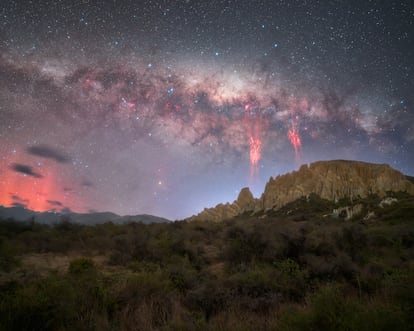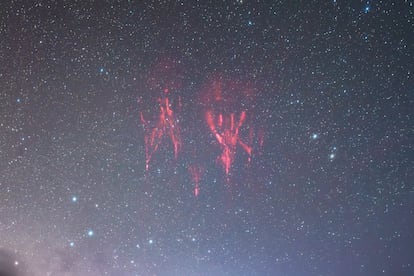A unique photo: How we captured the 'red spectra' and the Milky Way over New Zealand

Strictly opinion pieces that reflect the author's unique style. These opinion pieces must be based on verified data and be respectful of individuals, even if their actions are criticized. All opinion pieces by individuals outside the EL PAÍS editorial team will include, after the last line, a byline—no matter how well-known the author may be—indicating their position, title, political affiliation (if applicable), or main occupation, or any that is or was related to the topic addressed.
Spanish photographer Dan Zafra tells how he captured an image of an exceptional phenomenon.

Last Saturday, while taking photos under the dark skies of New Zealand with my Spanish colleague José Luis Cantabrana and local photographer Tom Rae, I experienced one of the most extraordinary nights of my life. From the Clay Cliffs on the South Island , I captured something I'd always dreamed of: red sprites (or red specters) shining over the Milky Way.
As far as I can see, there are no previous records of images or timelapses showing red sprites and the Milky Way in the southern hemisphere in the same scene, which makes this moment even more special.
To complete the evening, there was also a faint glow from the Aurora Australis and a small comet, SWAN, visible when zooming in on the images near the galactic nucleus.
The night of the captureOn the night of October 11, 2025, while photographing under a completely clear sky, I began to notice distant flashes on the horizon, originating from a storm over the Southern Alps. At first, they looked like normal lightning, but after some testing, I realized my camera was capturing red sprites .
Red sprites are massive electrical discharges that occur high above thunderstorms, reaching altitudes of up to 90 kilometers. They are almost impossible to see with the naked eye and last only a few milliseconds. Even the most experienced storm chasers can go years without seeing one. Being able to observe them here in New Zealand, where intense thunderstorms are rare, was truly exceptional.
What made the experience even more magical was how everything aligned perfectly: the sprites appeared right next to the galactic core, which was setting on the horizon. In the same frame, I could see the Milky Way shining brightly while these enormous red columns of light danced over a storm hundreds of miles away. It was one of those moments when you know you're witnessing something you'll probably never see again.

Red sprites are one of the rarest and least understood natural luminous phenomena. They were first recorded in 1989, and only a few photographers in the world have captured them in detail. They occur over very powerful thunderstorms when positive lightning strikes the ionosphere. Photographing one requires a perfect combination of conditions, patience, and luck—all of which occurred that night in New Zealand.
The importance of this captureTo my knowledge, this is the first time red sprites have been documented alongside the Southern Hemisphere's Milky Way and the Aurora Australis. For me, this image bridges two worlds: atmospheric photography and astrophotography, showing how ephemeral phenomena and timeless cosmic structures can coincide in the same instant. It's in moments like this that I'm reminded why I spend so many nights under the stars.
I'll never forget the adrenaline rush of seeing the first images appear on the camera and realizing what we had captured. I felt incredibly lucky to be there, in the right place, at the right time, and prepared for it.
The catch and the equipment usedShot details:
- Location: Clay Cliffs, South Island, New Zealand
- Date and time: October 11, 2025; 11:00 p.m. local time
- Camera: Sony A7III
- Lens: Sony GM 24mm f/1.4
- Sky exposure: 10 seconds, f/1.4, ISO 6400
- Close-up exposure: 2 minutes, f/1.4, ISO 6400
- Processed: Minimal contrast and noise adjustments; foreground blended for clarity, no star stacking or tracking
The result shows the sprites extending into the upper atmosphere with the Milky Way perfectly aligned; a scene that looked almost unreal through the viewfinder.
I also created a timelapse showing the sprites in real time. Since they only last a fraction of a second, the video captures the suddenness and power of these flashes.
Watching them move across the horizon was mesmerizing. The video offers another perspective, showing how these brief bursts of energy connect Earth's atmosphere with space in the blink of an eye.
Dan Zafra is a professional nature, landscape, and astrophotography photographer at Capture the Atlas
EL PAÍS



